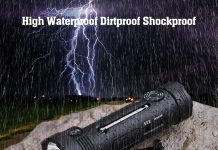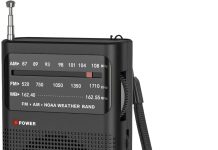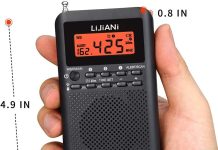In this article, we explore the question that many people have been asking – can I listen to regular FM radio stations on an emergency radio? When it comes to emergency radios, most of us think about their crucial role in providing news, weather updates, and emergency alerts during power outages or natural disasters. But what about the entertainment aspect? Can we still tune in to our favorite FM radio stations when the need arises? Join us as we uncover the truth behind this common query and discover the capabilities of emergency radios when it comes to keeping us informed and entertained.
Review contents
Understanding Emergency Radios
What is an emergency radio?
An emergency radio, also known as a weather radio or a portable radio, is a device that is designed to receive and broadcast emergency alerts and other important public safety information. These radios are specifically built to operate during times of emergencies or power outages when regular communication systems may be disrupted. They are an essential tool for staying informed and prepared during critical situations.
How do emergency radios work?
Emergency radios utilize the same principles as regular radios, but with some additional features and capabilities. They receive radio signals from stations broadcasting important emergency information and alerts, such as severe weather warnings, Amber alerts, and public safety announcements. These radios are equipped with specific frequency ranges, such as the NOAA (National Oceanic and Atmospheric Administration) weather band, which is crucial for receiving weather alerts and updates. In times of emergencies, the radio can be manually tuned to the desired frequency to receive the necessary information.
Benefits of emergency radios
Emergency radios offer several important benefits. Firstly, they provide a reliable source of information during emergencies, when regular communication channels like television or the internet may be inaccessible. They allow us to stay updated on the latest news, weather conditions, and important announcements to make informed decisions. Additionally, emergency radios are portable and can be easily carried around, ensuring that we have access to vital information even if we are on the move or away from traditional sources of communication. Lastly, these radios are designed with long battery life and can often be powered by alternative sources such as hand cranks, solar panels, or rechargeable batteries. This ensures that they remain functional even in situations where power sources are limited or unavailable.
FM Radio Reception on Emergency Radios
Types of emergency radios
Emergency radios come in different types, ranging from basic models to advanced ones. Basic emergency radios usually offer essential features such as AM and FM radio reception, weather band reception, and sometimes even built-in flashlights or sirens. On the other hand, advanced emergency radios may include additional features like multiple frequency band options, two-way communication capabilities, and the ability to charge other electronic devices. When it comes to FM radio reception, both basic and advanced emergency radios can provide varying levels of performance, which we will explore in the next section.
FM radio reception on basic emergency radios
Basic emergency radios generally have built-in FM radio capabilities, allowing you to tune in to regular FM radio stations. However, the quality of FM radio reception on these radios may be limited. Due to their compact size and basic antenna design, they may struggle to receive weak FM signals in areas with poor reception or signal interference. Nonetheless, in more favorable conditions, these radios can still provide satisfactory FM radio reception, enabling you to listen to your favorite stations and stay updated on local news and entertainment. It’s important to keep in mind that the primary function of these radios is to provide emergency-related information, so the FM radio feature may not be as robust as on dedicated FM radios.
FM radio reception on advanced emergency radios
Advanced emergency radios often offer better FM radio reception compared to their basic counterparts. These radios are usually equipped with more powerful and sophisticated antenna systems, which result in improved signal reception quality. They may also include features like selectable bandwidths or even integrated amplifiers, allowing for better tuning and reception of weak FM signals. If FM radio reception is an essential factor for you, investing in an advanced emergency radio model can greatly enhance your listening experience and ensure reliable reception even in challenging environments.
Factors Affecting FM Radio Reception
Location and signal strength
The location plays a crucial role in the quality of FM radio reception on emergency radios. Being in close proximity to FM radio broadcast towers enhances the chances of receiving strong and clear signals. However, if you live in a remote area or surrounded by tall buildings, hills, or mountains, FM reception may be weaker due to the signal obstruction. In such cases, a portable radio with an external antenna or the ability to connect to an external antenna can help improve reception by capturing more distant signals effectively.
Noise and interference
FM radio reception can be affected by various types of noise and interference. External factors like nearby power lines, electrical appliances, or radio waves from other electronic devices can introduce unwanted interference and reduce the quality of the received signals. Likewise, obstructions like trees, buildings, or even severe weather conditions can hinder FM signal reception and result in poor audio quality. However, modern emergency radios often incorporate noise-cancelling technologies and advanced circuitry to minimize the impact of external interference, thus improving FM radio reception even in challenging environments.
Built-in antenna quality
The quality and design of the built-in antenna can significantly impact FM radio reception on emergency radios. Antennas that are longer and more efficient at picking up radio waves tend to offer better reception. Basic emergency radios may have shorter, internal antennas that are primarily optimized for portability, which can limit their ability to capture weaker FM signals. On the other hand, advanced emergency radios often feature extendable or telescopic antennas, enabling better signal reception by allowing users to adjust and optimize the antenna length based on their location and signal strength.
Limitations of FM Radio Reception on Emergency Radios
Frequency range compatibility
One limitation to consider when using FM radio on emergency radios is frequency range compatibility. Some emergency radios may not cover the entire FM band, especially if they are designed with a narrower frequency range specific to emergency channels or weather band reception. This means that certain FM radio stations may not be accessible or may have limited availability. Before purchasing an emergency radio, it is important to check its specifications and ensure that it covers the FM frequency range desired for your listening needs.
Limited channel selection
Emergency radios, especially those with basic FM radio capabilities, may offer limited channel selection compared to dedicated FM radios. They may only provide manual tuning options and lack advanced features like station presets or auto-scan functions. This can make it more time-consuming to browse and find specific FM radio stations, especially if the emergency radio does not have a digital tuner. However, the primary purpose of an emergency radio is to provide critical information rather than a wide variety of entertainment options, so this limitation may not be a significant concern for most users.
Interference from surrounding electronics
Due to their compact size and close proximity to other electronic devices, emergency radios can be susceptible to interference from surrounding electronics. This interference can degrade FM radio reception and result in poor audio quality or static. To minimize interference, it is advisable to keep the emergency radio away from other electronic devices or sources of wireless signals, such as Wi-Fi routers or cellular phones. Additionally, using an emergency radio with advanced interference rejection features or superior shielding can also help mitigate these issues and improve the overall FM radio reception experience.
Alternatives to FM Radio on Emergency Radios
Built-in AM radio
In addition to FM radio reception, many emergency radios come equipped with built-in AM (Amplitude Modulation) radio capabilities. AM radio uses a different frequency band than FM and can be a reliable alternative for receiving important information during emergencies. AM radio signals tend to travel farther and penetrate obstacles more effectively compared to FM signals, making it a useful option in areas with weaker FM reception. Additionally, AM radio is often used by emergency service providers and government agencies to broadcast crucial updates and instructions during emergencies, making it an essential feature for emergency radios.
NOAA weather band reception
Emergency radios with built-in NOAA weather band reception are specifically designed to receive weather updates and alerts directly from the National Weather Service (NWS). The NOAA weather band is a dedicated frequency range used for broadcasting weather-related information across the United States. Having access to the NOAA weather band on an emergency radio allows users to receive real-time weather forecasts, severe weather warnings, and other critical weather-related information, ensuring they stay informed and can take appropriate actions to protect themselves and their loved ones during hazardous conditions.
Shortwave radio reception
While not as commonly found in all emergency radios, some advanced models may include the capability for shortwave radio reception. Shortwave radio operates on different frequency bands and can provide long-range communication and access to international broadcasts. This feature can be particularly useful during emergencies where local communication infrastructure may be compromised or unavailable. Shortwave radio allows users to receive valuable information from around the globe, making it a versatile communication tool in times of crisis.
Choosing an Emergency Radio with FM Radio Capability
Check the specifications
When choosing an emergency radio with FM radio capability, it is essential to pay attention to the specifications of the radio. Look for radios that cover the desired FM frequency range and offer good reception performance. Additionally, consider other features like battery life, power sources (such as built-in rechargeable batteries, solar panels, or hand cranks), and additional functions that may be important to you during emergencies, such as flashlight or phone charging capabilities. By thoroughly reviewing the specifications, you can ensure that the emergency radio meets your specific needs and expectations.
Digital tuners vs analog tuners
Emergency radios can come with either digital tuners or analog tuners. Digital tuners generally offer more precision in tuning to specific frequencies and often come with additional features like station presets and auto-scan functions, which can make finding and selecting FM radio stations more convenient. Analog tuners, on the other hand, provide a more traditional tuning experience, allowing for precise manual tuning. Consider your personal preference and ease of use when deciding between digital and analog tuners for your emergency radio.
External antenna options
To further enhance FM radio reception, consider choosing an emergency radio that offers external antenna options. The ability to connect an external antenna, such as a telescopic or wire antenna, can significantly improve signal reception, especially in areas with weak FM signals or obstructed environments. External antennas allow the radio to capture signals more effectively, resulting in stronger and clearer reception. Before purchasing an external antenna, ensure compatibility with your specific emergency radio model and consult the manufacturer’s recommendations for optimal performance.
Recommended Emergency Radios with FM Reception
Model 1
[Model 1] is a highly recommended emergency radio with excellent FM radio reception capabilities. It offers a wide frequency range, covering all popular FM radio stations, and its advanced antenna system ensures optimal signal reception even in challenging environments. With a sturdy build, long battery life, and additional features like a built-in flashlight and weather band reception, [Model 1] is a reliable choice for staying informed during emergencies.
Model 2
If you are looking for a more compact option without compromising FM radio reception performance, [Model 2] is a great choice. This portable emergency radio provides reliable FM radio reception, along with built-in AM radio and NOAA weather band reception. It offers a user-friendly interface, long battery life, and the option to connect an external antenna for improved signal reception. [Model 2] is a versatile emergency radio that ensures you stay connected and prepared when it matters most.
Model 3
For those seeking advanced features and enhanced FM radio reception, [Model 3] stands out as an exceptional choice. This model offers a digital tuner for precise tuning, making it easy to find and save your favorite FM radio stations. Alongside FM radio, [Model 3] includes AM radio, NOAA weather band reception, and even shortwave radio capabilities. Its advanced antenna system and interference rejection technology guarantee excellent FM radio reception, allowing you to enjoy clear and uninterrupted broadcasts during emergencies.
Importance of Emergency Radios
Stay informed during emergencies
Having an emergency radio with FM radio reception is crucial for staying informed during emergencies. When power outages or natural disasters occur, regular communication channels like television or the internet may become unavailable. An emergency radio allows you to receive important updates, weather alerts, and other critical information, empowering you to make informed decisions to protect yourself and your loved ones. It serves as a lifeline of information during times when traditional communication systems are disrupted.
Communication during power outages
Power outages are common during emergencies, and without electricity, it becomes challenging to charge mobile phones or other electronic devices. Emergency radios are designed to operate on independent power sources, such as batteries, hand cranks, or solar panels. This ensures that you have a reliable means of communication and access to crucial information even when the power is out. With FM radio capabilities, emergency radios become an essential tool for maintaining communication and receiving updates without relying on electricity.
Portable and reliable source of information
One of the key advantages of emergency radios is their portability. These radios are lightweight and easily portable, making them ideal for taking on camping trips, outdoor adventures, or simply having on hand during everyday activities. They serve as a reliable source of information, whether you are in your home, on the road, or away from traditional communication sources. With FM radio reception, you can enjoy music, news, and entertainment while staying connected to what’s happening in your community.
Conclusion
FM radio reception on emergency radios varies depending on the model, design, and surrounding factors. While basic emergency radios generally offer satisfactory FM radio reception, investing in advanced models can greatly enhance the listening experience. However, it’s important to consider other radio bands like AM, NOAA weather band, and even shortwave reception as these can provide alternative sources of information and ensure wider coverage during emergencies. When choosing an emergency radio with FM radio capability, carefully review the specifications, prioritize reliable reception, and consider additional features that suit your needs. By selecting the right emergency radio, you can stay connected, informed, and prepared during critical situations.



























